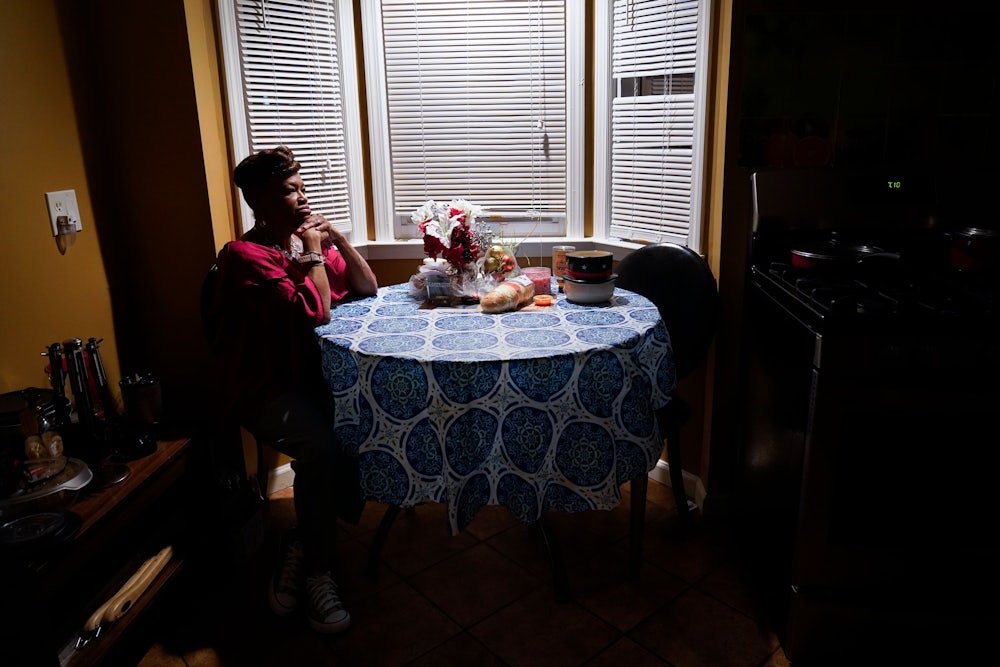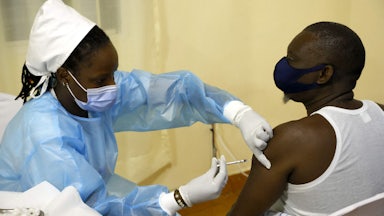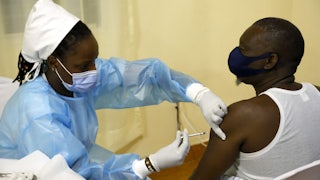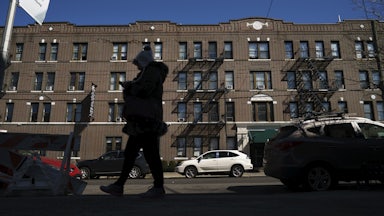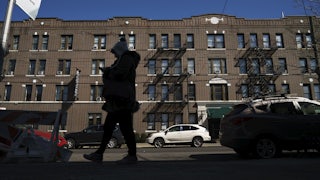Tiffany Nazaire felt her first Covid symptoms last October and was diagnosed—along with many of her colleagues at the hospital where she worked—later that month. In the nine months that have passed since then, shortness of breath has landed the 38-year-old in the emergency room multiple times; persistent brain fog, memory loss, and fatigue have made her unable to return to work as a nurse in the Baltimore area.
Nazaire soon found doctors were slow to acknowledge her ongoing symptoms. Emergency room physicians dismissed her shortness of breath as panic, she said, sending her home with a prescription for anti-anxiety medication. When, in December, she visited the University of Maryland Comprehensive Care Clinic, she says the attending nurse did not take her long-haul symptoms seriously. She was told that because she hadn’t been hospitalized, other than her brief emergency room visit, her symptoms were too mild for her to be admitted to their clinic for long-haul patients. In a medical chart Nazaire shared with The New Republic, there is no documented mention of her post-infection symptoms, though they were the reason for her visit. (Contacted by The New Republic, University of Maryland Upper Chesapeake Health would not comment on the specifics of an individual patient’s care or recovery and did not provide eligibility criteria for receiving long-haul Covid treatment at its medical centers.)
Nazaire reached out to other clinics but either didn’t hear back or found there were state residency requirements that prevented her from enrolling. “There were so many roadblocks to care,” Nazaire told me. “That was one of the most depressing things about it.”
Nazaire’s challenges are not unique. Even as the worst of the pandemic subsides in much of the United States, a growing body of research points to an evolving, long-term crisis: Around a quarter of Americans who contracted Covid-19 face enduring symptoms that, for many, keep them out of work and struggling to cope with mounting medical bills. And although data is just starting to come in, experts say the “long Covid” crisis will mirror the pandemic itself, creating a “tsunami of disability” that will take a disproportionate toll on low-income people of color.
It’s become a common trope that the pandemic has exposed long-standing inequities in the U.S. health care system, but as the country begins to reckon with the scope of long Covid, there’s little indication it’s learning from past mistakes. Instead, Americans struggling with post-Covid symptoms face a highly unequal health care landscape, with the most vulnerable populations navigating labyrinthian barriers to treatment. For many, persistent and devastating symptoms have made it difficult to return to work—even as medical bills pile up. With many pandemic-era assistance programs set to expire by the end of the summer, this growing population of Covid long-haulers faces an especially uncertain future.
“All estimates indicate that low-income communities of color, who were disproportionately hit by Covid, will be disproportionately hit by long Covid,” said Sabrina Assoumou, an infectious diseases physician at Boston Medical Center and an assistant professor of medicine at Boston University School of Medicine. “And because some of the hardest-hit communities are in areas with a lot of disinvestment and limited access to health care, one of the biggest barriers will be finding someone to diagnose you and make sure you get the care you need.”
Indeed, access to the emerging long-Covid health care landscape—defined in large part by specialized, multidisciplinary clinics—is hardly straightforward. Clinics are overwhelmingly concentrated at large medical centers and beset by extensive waitlists, insurance constraints, and strict eligibility requirements. Until recently, most clinics required that patients present proof of a positive Covid test—a roadblock for individuals who got sick early in the pandemic, when testing was limited, especially in underserved communities. (A study from earlier this year indicated that 20 percent of U.S. counties lack a single test site, primarily in low-income rural and urban areas.)
And although testing became more widely available as the pandemic escalated, the difficulties some patients faced early on have followed them as their initial Covid infection has settled into a long-term illness. Chimére Smith, a former middle-school teacher in Baltimore, first felt Covid symptoms in March 2020, when the Centers for Disease Control and Prevention recommended using limited testing resources on patients who were hospitalized, had preexisting conditions, or had traveled to international hotspots.
“My doctor said, You don’t have a fever, you don’t have Covid,” Chimére told me. Instead, her doctor suggested she had a sinus infection. But Smith’s symptoms only worsened, from migraines and brain fog to, a month after she first felt sick, losing vision in her left eye. Last August, she says she sought care at Johns Hopkins’s long-Covid clinic but was told that absent a positive Covid test, she couldn’t be treated. Attending physicians noted on Smith’s medical documents, reviewed by The New Republic, that she was experiencing anxiety, and recommended psychiatric treatment. A physician with the Hopkins long-Covid clinic—where the waiting list is currently seven to nine months—told The New Republic that he does not require patients to present a positive Covid test for treatment, noting that he will see anyone who continues to experience chronic fatigue, elevated heart rate, or “disabling symptoms” more than three months after a Covid infection. But other clinics contacted by The New Republic said they continue to require a positive Covid test to receive care for long-haul symptoms. According to a National Institutes of Health study released last month, an estimated 17 million cases had gone undiagnosed by mid-July 2020. For those who face persistent symptoms but whose initial infections went undiagnosed—overwhelmingly those in low-income urban and rural communities, as well as undocumented people who avoided Covid tests due to immigration status concerns—a positive test requirement poses a significant barrier to treatment.
“For a race of people who historically don’t like to go to the doctor because we’re not treated well,” said Smith, who is Black, “adding pieces to the puzzle isn’t going to encourage us to seek care.”
Long-Covid clinics are relatively new and continue to evolve with growing research on the illness. But so far, they’re concentrated at major medical centers—and out of reach to people in rural settings or areas otherwise cut off from transportation, said Ada Stewart, president of the American Academy of Family Physicians and a family physician with Cooperative Health in Columbia, South Carolina. “Once again, we’re missing the people in rural areas, the people I’m seeing every day,” she said.
Even as more hospitals launch clinics to serve long-haul patients, some states—North Dakota, South Dakota, Nebraska, West Virginia, Mississippi, Vermont, Alaska, and Maine—don’t have a single one.
Stewart points to additional factors driving disparities in access to long-Covid care: access not only to insurance but to a primary care physician who knows a patient’s medical history and, critically, can refer them to specialists for the litany of long-haul symptoms they might face. People of color—especially Black Americans—are significantly less likely than white Americans to see a primary care or family medicine doctor. And nonprofit community health centers, where many low-income and underinsured Americans have long sought care, are emerging from the pandemic weaker than ever.
“As a primary care physician, I take care of the total person, and we need to do everything we can to improve access to that type of care,” Stewart, who works at a community health center, said.
Carina Marquez, an assistant professor of medicine at the University of California, San Francisco, School of Medicine, has focused on increasing representation of nonwhite patients in research on long Covid. “For the most part, research cohorts have not reflected the ethnic and racial makeup of Covid, and undersamples Black and Latino patients, in particular,” she said.
That in part stems from who’s able even to enter clinical settings. “The first step is just getting in the door, and many patients don’t have a primary care doctor or don’t have insurance,” said Marquez. Without those resources, “you may not even enter the door. That’s one of the biggest issues we’re seeing all over the United States.”
Abha Agrawal, chief medical officer at Humboldt Park Health, a community health center on the west side of Chicago, launched a long-Covid clinic when she realized that the only long-haul treatment centers were at Northwestern and the University of Chicago. “These academic research centers have a very different mission, a different goal in the health care ecosystem,” she said. “They have a valuable role to play in advancing science. But clinics like ours have an invaluable role to play in making sure people can access care regardless of how they look, how they talk, or whether they have insurance or a positive Covid test.”
The many unknowns around long Covid exacerbate long-standing disparities in health care access. It wasn’t until mid-June that the CDC issued official guidance on treating “post-Covid conditions,” well over a year after advocates began sounding alarm bells over the scope of the growing crisis—and turning to online communities, such as Survivor Corps and Body Politic, for support. And while the CDC proposed a diagnostic code for long-haul symptoms—which patients can use to bill insurance for related treatment—one has not yet become available.
Diana Berrent, who founded Survivor Corps, worries that the slow response to an escalating crisis will have repercussions down the line, as the long-term effects of post-Covid symptoms continue to play out. Without a billable insurance code, she said, “there will be no way to track people longitudinally, to see who followed up later for long Covid. There needs to be a major effort, and soon, because the data will be lost.”
For long-haul survivors, struggle accessing care has fueled financial hardship. While dealing with her symptoms, Nazaire—who, by April, was finally admitted to Johns Hopkins’s long-Covid clinic—received worker’s compensation and “was able to make things work” financially. But when, after four months, she told her employer she wasn’t ready to go back, they terminated her job. She requested to work remotely, on her doctor’s suggestion, but her employer rejected the proposal. (She is currently taking legal action against her employer.)
And Smith has yet to return to her job teaching. “People ask me, am I going to go back to work? And I say, how? How can I work? I have memory loss, joint pain, back pain, brain fog I never had before I was sick.”
Even patients who were well placed to access care have still struggled to receive treatment and, months into their symptoms, are bearing the financial brunt. Davida Wynn, who was a nurse leader at an Atlanta-area hospital prior to contracting Covid-19, said she spent six months reporting symptoms to her primary care physician before she received referrals to specialists.
“That was the most painstaking part, getting the ball rolling for referrals,” she said, adding that she drew on information she learned from long-Covid support groups on Facebook to advocate for further care. Wynn has yet to return to work and has been receiving 60 percent of her salary in disability benefits. Her employer denied a recent request to extend disability, on the grounds that her ongoing symptoms stem from “behavioral health conditions”—depression and post-traumatic stress disorder. Wynn refutes this characterization of her illness, arguing that she still uses a walker to get around; she regularly paused during our conversation, to catch her breath.
Financially, she’s managed to stay “just above drowning level” but worries that won’t last; she’s considering selling her home, which she purchased in 2016. “To go from 38 and fully functioning,” she said, “to 39 and needing assistance for basic tasks, and unable to work, that takes a toll on you.”
This story was supported by the Economic Hardship Reporting Project.
